| Pages:
1
..
47
48
49
50
51
..
60 |
halogen
Hazard to Others
  
Posts: 372
Registered: 18-4-2004
Member Is Offline
Mood: No Mood
|
|
Sorry if it's been mentioned many times before, but this thread is long.
An old source singles out lead phosphate as yielding phosphorus "readily" when heated to redness with charcoal.
Why is this? Because lead is easily reduced, melts, and doesn't form a stable phosphide?
Bismuth is not as toxic and is similar in these ways.
Zinc and tin, which melt, form phosphides. Bismuth and aluminum form a eutectic if that is relevant.
Bismuth has been mentioned in this thread only in the context or reduction by hydrogen which it allows at about 425 vs 575 degrees for lead.
If that translates also to ease of reduction by carbon or even aluminum, you have a wiener. Bismuth can of course be recycled from
its atoms.
| Quote: | Here is a reproduction of the table provided listing phosphates that are reduced at low temperature to phosphorus, the temperature listed is the
temperature at which the reaction becomes rapid which was determined by looking at the increase of the partial pressure of water formed by the
reaction:
Phosphate ........... Decomposition Temperature (°C)
BiPO4 ..................... 425
Ag3PO4....................425
SbPO4......................450
Pb4(PO4)2................575
3Pb3(PO4)2*PbCl2...600
Hg3PO4.....................600
Hg3(PO4)2................600
SnO2*P2O5..............600 |
from https://www.sciencemadness.org/whisper/viewthread.php?tid=65...
Strepa tried reducing lead phosphate with H2, and had this to say:
| Quote: |
Last picture is apparatus being disassembled. Only a film of P was produced—no quantity of any significance. The viability of this as a practical
technique for producing even laboratory amounts (a few grams) remains to be demonstrated.
|
https://www.sciencemadness.org/whisper/viewthread.php?tid=65...
[Edited on 9-2-2016 by halogen]
[Edited on 9-2-2016 by halogen]
[Edited on 9-2-2016 by halogen]
F. de Lalande and M. Prud'homme showed that a mixture of boric oxide and sodium chloride is decomposed in a stream of dry air or oxygen at a red heat
with the evolution of chlorine.
|
|
|
byko3y
National Hazard
   
Posts: 721
Registered: 16-3-2015
Member Is Offline
Mood: dooM
|
|
halogen both of your links are invalid to me. There's a link above every message (like "posted on 9-2-2016 at 17:22" on top of
yours), which can be used to correctly locate the message.
The correct links are:
viewthread.php?tid=65&goto=search&pid=247864
viewthread.php?tid=65&goto=search&pid=90581
|
|
|
BluePlanet1
Harmless

Posts: 41
Registered: 30-1-2016
Member Is Offline
Mood: No Mood
|
|
UPDATE!
My camera came, I am well stocked with 5 lbs of NAPO4, 3lbs AL, 2lbs Mg, 20lbs SiO2, a bag of coal and have some VERY interesting news to report.
My first "large scale" reaction (20gms and I used air-MAP with NO HHO) my reducer and distiller failed in the respect most the WP hardened in the
reducer and didn't even get to the distiller. I tried coercing some of the WP out then realized that wasn't happening. Anyone who read my last post,
the sandwich seal I made with a AL|SiO2|AL ... although it blocked out oxygen like a weld would ... I could not overheat that section of the reducer
to move the WP out the distiller and through the water. If I overheated the reducer (where most got stuck) that seal would have melted and broke.
I just didn't wanna risk it so I plugged the distiller with wet cotton then vacuum sealed the whole thing in a ziplock bag. I will try to extract that
WP at a later time.
NOW here's what I did!
I built another retort the same exact way like an idiot. For 2 reasons:
1) It's quick, easy & I already had the materials (I'll fix the reducer problem my next trip to Lowes).
2) I realized the Magnesium I already have in my home, although it's not ultra fine mesh it may work for what I originally wanted to test.
I ordered this MG like a year ago cause it was discounted. It's an undesirable mixture of different meshes, larger sand sized grains along with some
chunks. Like when manufacturers powder MG, they get it all over the place, sweep it up and sometimes sell it cheap rather than throw it away. It's a
bit impure but I got it at the time cause I wanted powder and flakes.
Now to the story. I took my regular mixture of 34G NAPO4, 15G AL & 10G SiO2.
Out of impatience (I'm also waiting for some nondiscount pyro MG) I decided to screen out some MG powder and get my coal.
And then I changed the mixture ratio to 34G NAPO4, 9G AL, 3G MG, 3G C (coal) & 10G SiO2.
Then I loaded up my retort and packed it in. I put on my $40 Lowes respirator mask and lit the MAP torch. Again not using HHO. Then I started heating
the retort and ***SOMETHING MIRACULOUS*** happened! The reducer breached a little needle size hole through the teflon seal. At which point I started
seeing a small stream of meteor-like WP burning & smoking up.
I figured the breach was small and so I continued heating. Then 2 MORE breaches opened and now I had 3 holes releasing and burning WP at the top of
the retort.
But here's the crazy part. As the reaction kept going I saw a HUGE RELEASE of gas in the water. This was after there were already 3 breaches with WP
burning there was still gas coming out the distiller. And it wasn't exploding out. It would push a stream of bubbles, stop, do it again, stop, more
gas... like someone was opening and closing a CO2 valve.
The slag was also different. In the past I'd let the reaction go, then reapply and heat the hell out of it to drive WP out. But it would come out in
violent short bursts and end abruptly. That's usually when I applied HHO to force the reaction further but the bubbles died 4-5 seconds later. After
that it was "dry".
This mixture doesn't do that. I've seen many people talk about viscosity reducers but I haven't seen many talk about "gas carriers" and I think that's
what's happening hear. From what I see the MG is making the slag more reactive but also more cooperative. And when the C changes state as the AL/MG do
it's thing it's driving MORE HOT GAS through the slag which is pulling out more vaporous P2 with it.
The reason I say this is because:
1) Significantly more gas was released.
2) The gas was distributed more consistently.
3) The amount of WP that burned up at the breach was a HUGE amount. There were basically 3 mini stars burning for 10-12 minutes straight as gas was
still coming out the distiller.
4) Although I lost most my WP, the P4 I did collect is the cleanest white phosphorous I've ever seen.
At first I looked weird cause it had NO yellow tinge anywhere. Then I tried the melt test and it passed. Added ice. Chopped off a piece and threw it
wet on a towel. It smelled atrocious. I held it in front of a space heater, it took on smoke, ignited then looked like a mini volcano.
I'm now 100xs more interested in testing different ratios of AL/MG/C. To see how it impacts yield. And if it does indeed make it easier to gas out
more P4 which I believe it does. Just a matter of finding the right balance.
Also, I'm not filming yet for a few reasons. First, I need to finish my adjustable table mount with clamps. The way I work now is pretty
unprofessional holding both the retort and torch and each hand. I'm also waiting for this "polar vortex" to end so I can move back to my workshop
instead of the bathroom. And also need a smaller reducer.
These first 2 runs may not have gone as planned. But I KNOW this mixture needs MG & Carbon. Mark my words. The P4 needs a better source of gas
(other than itself) to push it out. To help it stay in gas state so it leaves the distiller better. Then it needs the MG to keep the slag reactive
enough to burn the most Carbon possible. Magnesium also burns slower with larger particle sizes. So adding coarser powder will slow it's burn and help
replace even more Al with MG.
I'm really curious why all these years noone has tried a mix of MG to C ?
It seems like an obvious symbiotic relationship. Remove AL, use MG, slow its burn down with C to gas out more P.
Now I'm ranting. Trial 3 will go on video.
|
|
|
Magpie
lab constructor
    
Posts: 5939
Registered: 1-11-2003
Location: USA
Member Is Offline
Mood: Chemistry: the subtle science.
|
|
It is nice to see someone experimenting again. Please be careful. "In my bathroom..." (shudder)
What is NAPO4? Do you mean Na3PO4? Most of my work was done with NaPO3 (FYI).
The single most important condition for a successful synthesis is good mixing - Nicodem
|
|
|
BluePlanet1
Harmless

Posts: 41
Registered: 30-1-2016
Member Is Offline
Mood: No Mood
|
|
Quote: Originally posted by Magpie  | It is nice to see someone experimenting again. Please be careful. "In my bathroom..." (shudder)
What is NAPO4? Do you mean Na3PO4? Most of my work was done with NaPO3 (FYI). |
Magpie! Thank you for the well deserved warning. You might shudder more if you knew I work with chemical and biological (mostly bio) toxins for a
living. So I'm NIOSH, AIHA, IAQA NAETI, ESA, etc certified.
The issue is we (me and my brother) store all our zip walls, tychem suits, survivair, negative air machines, etc at my brothers new house.
Then also I moved to the marketing side of the business 4 years ago. So I really don't work with hazardous materials as much as I use to.
And yes, it's NaPO3. I keep mixing that up with the PO4 from TSP which is what I started with. Then I moved to TCP and now I only use the hexameta.
While I'm on the topic of SAFETY I'd like to say 1 thing about phosphine which *may* help a few broke souls. And before I do please keep in mind I am
NOT recommending anyone does this. I'm qualified to advise on certain industrial air scrubbers. But I am NOT qualified to recommend anyone alters
their respirators (assuming you use one).
With that said, this is one of my custom masks that I've personally been using over 6 years. I've shown it to toxicologists, industrial hygienists,
air quality consultants... they warned me about the seal but the seal always works when done right. And the benefit of this mask is:
1) It scrubs significantly more air, debree & toxins than the $25 refill cartridges that have to be replaced literally every other time you use
them. Even if you're doing something as simple as painting you'll notice those cartridges go bad after about 16-24 hours of use.
2) When I started out there were many times I'd get sore throats or headaches from the silver encapsulants or other chemicals we were using. This mask
stopped that. I never got a sore throat or headache again.
3) There's been a few times I've accidentally been exposed cause I thought my cartridge was still good. Or because the previous lab did the wrong
tests (or not enough tests). Then I'd wind up in bed sick as hell for days sometimes weeks. Only one time have I been to the ER and that was one of
the scariest feelings in the world.
Generally speaking most our cases are low to medium risk. So most the time I didn't wanna work in a bulky tychem suit or use a full face respirator.
I'd opt instead for a hooded tyvek suit and the respirator I'm gonna show now. In more serious cases I'd def opt for something like tychem.
But this is my point. Over the years I noticed a serious problem where in most low-medium risk cases.... so many people, even qualified people would
sacrifice their health cause it was A) more comfortable or B) more affordable. Like after Hurricane Katrina. OSHA changed their guidelines to allow
the use of cheap n-95 masks to protect workers from toxic mold exposure. Tons of workers wound up sick. 9-11.... I won't even get into that.
So let me get to the point. This mask is filthy and I usually clean it with alcohol so it looks nice and new.
But these are the masks you're likely to find at Lowes or Home Depot:
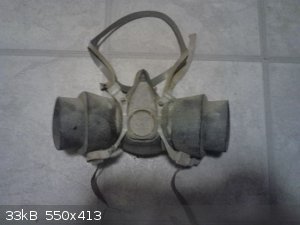
The only difference is they don't come with those huge black custom made scrubbers on the end.
They come like this. Look at the right of the mask not the black piece. That little screen looking thing is the cartridge they provide you with that
you're suppose to replace.
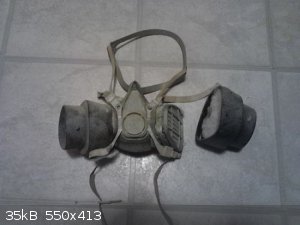
Now I turned the "custom scrubber" upside down. You see polyester fiber. Under that fiber is A LOT of activated carbon. Then another layer of fiber on
the other side.
I flipped it over. So you see a thin plastic screen with vent holes and the fiber underneath.
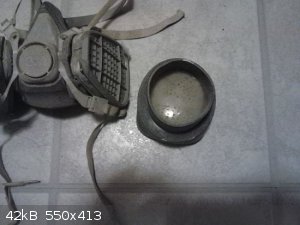
People may be looking at this and thinking "I'm not building a custom scrubber are you crazy?"
But that big black rubber scrubber piece.... both Lowes and Home Depot SELL THEM right in the gutter aisle. They're about $6 each and they're all the
same size. Buy 2. I accidentally figured out that the large end fits PERFECTLY, like a glove, right over the cartridge that's ALREADY ON the
respirator. This way you're not actually "altering" anything. You're not breaking, removing or doing anything to the original cartridge that comes
with the mask.
All I did after that was simple:
1) Cut plastic circles (any flat, thin, plastic material works). The piece just lays in. I drilled a bunch of small holes in that plastic then
permanently epoxied it to the rubber.
2) I packed a nice big wad of polyester fiber.
3) I pour dry activated charcoal (fish tank stuff) onto a metal strainer, shake over a garbage can to get the dust out. Then put a whole bunch in the
mask. Around 1/2 - 3/4 cup.
4) Pack another layer of fiber to sandwich in the charcoal (fish stores sell the fiber).
5) After that you slip the whole thing on tight. Then what I personally do is clean the edges with alcohol and tape it to the bottom edge of the
cartridge with black electric tape. It creates a super tight seal cause you can't breath if you put your hands over the black scrubbers.
Now here is what I do for PHOSPHINE.
Very simple. Do the mask as I listed before. Except you need copper sulfate. Create a saturated solution. Pull off the top fiber then spray it on the
coal so it's "moist". I do 1 spray, mix the coal, another, usually just 3-4 sprays till it looks black and moist. The fiber should stay white
otherwise you used too much. Then let the outer C dry a tiny bit, throw the fiber back on and reseal it.
This is how phosphine scrubbers are built: http://ftic.co.il/2000FresnoPDF/83.pdf
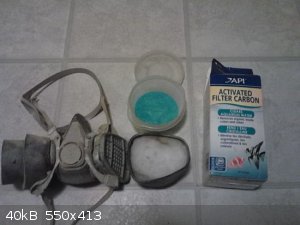
It may seem crude but I love this mask. It's designed to scrub a lot of air, it lasts for months, the original cartridges only get dirty maybe once or
twice a year. But more importantly for phosphine, studies show you need MOIST charcoal with copper sulfate to properly scrub.
When you're done using it throw it in 3 plastic bags sealed tight to keep the moisture in. If it dries just add some water. AFA how long to use?
That's too relative. But I'd say it's good for a lot of cooks if you store it properly.
I wouldn't step into a room full of phosphine with a mask like that. But for homemade quantities of P4 I feel 100xs safer using that mask then my
survivair or what comes off the shelf at Lowes or Home Depot. In the end everyone should have great ventilation. A fumehood or airscrubber. And I'll
be picking up a mini air scrubber from my brother but I'll still be using this mask. Even if I was doing this outdoors so many people have died from
aluminum phosphide / phosphine fumigants that countries are banning them.
Everyone please stay safe. =]
|
|
|
Magpie
lab constructor
    
Posts: 5939
Registered: 1-11-2003
Location: USA
Member Is Offline
Mood: Chemistry: the subtle science.
|
|
My safety concern was meant more for skin burns. At least two of our members have experienced painful phosphorus burns. It is especially
enlightening to read the story told by rogermeryaw. He had to go to the hospital for liver damage.
I also consider white P to be a serious fire hazard. I converted all of mine to PCl5 for that reason.
I appreciate the information you have given us on using PPE. I have a powerful fume hood and don't use a mask. If I felt I also needed a mask I
would likely not do the experiment.
The small amount of phosphine I have generated during my experiments seems to quickly burn off with small pops and flashes of light.
The single most important condition for a successful synthesis is good mixing - Nicodem
|
|
|
BluePlanet1
Harmless

Posts: 41
Registered: 30-1-2016
Member Is Offline
Mood: No Mood
|
|
Quote: Originally posted by Magpie  | My safety concern was meant more for skin burns. At least two of our members have experienced painful phosphorus burns. It is especially
enlightening to read the story told by rogermeryaw. He had to go to the hospital for liver damage.
I also consider white P to be a serious fire hazard. I converted all of mine to PCl5 for that reason.
I appreciate the information you have given us on using PPE. I have a powerful fume hood and don't use a mask. If I felt I also needed a mask I
would likely not do the experiment.
The small amount of phosphine I have generated during my experiments seems to quickly burn off with small pops and flashes of light.
|
Interesting. I recall his post about phosphorous being a "backstabbing bitch" but nothing about the hospital or liver damage. Very scary stuff. I can
only hope that he (and the other member) were not touching it with their hands.
With me, I'm not that worried about the fire hazard. That's post production I should say.
My biggest fear is the phosphine. And it's because of how I was introduced to this reaction roughly 6 months ago. A book called "General Chemistry" by
Linus Pauling. Published 1970, 945pgs big. In the entire book, there were only 5 short lines about making WP:
"Elementary phosphorous is made by heating calcium phostphate with silica and carbon in an electric furnace. The silica forms calcium silicate,
displacing tetraphosphorous decoxide, P4O10, which is then reduced by the carbon. The phosphorous leaves the furnace as vapor, and is condensed under
water to white phosphorous".
That was it. So I went online... was researching for hours & never saw this thread. I never saw Rogers video cause it wasn't keyword optimized. I
saw Red Niles channel. Very smart guy. So I asked him if he ever tried this synth and he said "no, but if you succeed please message me."
So I mixed TSP with damprid in saturated solutions. Boiled them. The whole thing solidified. I assumed that was pure TCP, washed, filtered &
dried.
I mixed that with silica and carbon then applied pure HHO to it. Just to "observe" if anything would happen doing this in open air. 3-4 minutes later
that mixture lit up like a star ... within seconds my whole house was just plumes of smoke so I grabbed my dog and threw her in the backyard. Run back
in coughing, choking, eyes watering, my throat was burning like I ate a ghost pepper. I'm plugging in fans, opening windows, worried about
neighbors... wondering where my gas mask is.... 2 mins later I had to go outside. Then took my dog for a long walk.
As I was walking my dog towards the beach I didn't feel right. My throat was better but my heart was palpitating in a very weird and noticeable way. I
was hitting my chest with my hands. I felt flush but cold. My nerves felt "tazed" in a weird way. Like a low current of electricity was going through
my body it felt really weird. And IDK what caused that reaction I just know it was something in the air.
When I later found this thread and read about phosphine that's when I became phosphine-phobic. Because P4O10.... afaik... it's not that toxic. It's
toxic in a tear gas type of way but not in a "let me hijack your nervous system & try to kill you" type of way.
There's a side of my brain that says "that reaction was too hot for phosphine and had no AL." It was hot enough to sublime all that carbon in a matter
of seconds and looked a bit like plasma.
Then I thought.... "what if the free hydrogen from the HHO was combining directly with the phosphorous?" The same way H2 from HHO embrittles steel at
high temperatures.
The larger more current reactions I've run I can see PH3 popping and exploding in the water. So it seems like most of it burns right up. At the same
time, how do we even know that's PH3 exploding and not P2 vapor hitting the air? Both burn orange. Maybe it's a mixture of both. And maybe P2 vapor
can steal the oxygen PH3 might use... then blow that out into the air. So it diffuses before it can burn.
Anyway, none of this ranting will matter when I pick up my air scrubber. The weather is also warming this week which is great. Pyro MG should be here
tomorrow. I'm may increase the amount of MG/C for trial 3 on camera. Hopefully be ready in a few days. 
|
|
|
BluePlanet1
Harmless

Posts: 41
Registered: 30-1-2016
Member Is Offline
Mood: No Mood
|
|
Hello all,
Just letting the forum know that I haven't disappeared. I've been plundering the depths of Lowes, Home Depot, Harbor Freight... bought an arc
welder... grinder.... tried to teach myself to weld and many other things.
One of the hardest parts of making P4 is the "plumbing" on this final device. It was me trying to matchmake pieces for hours. I asked and spoke to
tons of employees. None were plumbers or welders. So I taught myself about welding, plumbing, compression fiitting, threads, etc.
The new retort I made is very simple but interesting. It's 2 pieces of steel and 4 pieces of brass. You can buy everything at Lowes. I will get
pictures and a video up soon.
The best part about this new retort is it's HIGHLY scalable. You can easily increase the amount of P4 just by having enough air-propane torches or 1
single good air-propane torch to drive a lot of air-propane at the main pipe. That would heat up hot as hell and distill into a middle pipe, where it
collects on the surfaces, then the water.
Afterwards I can turn the heat up on the "predistiller" to drive the rest slowly into the water.
I like this idea of using pipes instead of cans to make WP. And to be fueled by a jet of air propane. I have 4 air-propane torches which should be
enough when I begin to scale. All 4 turned into the same direction create a miserably hot center of focus. But next I'm just buying a large propane
tank. And I may divide all 4 heads to disperse them around the furnace.
I may wind up building a mini industrial WP machine. One big propane tank would be plenty. I have to do this.
[Edited on 7-3-2016 by BluePlanet1]
|
|
|
Magpie
lab constructor
    
Posts: 5939
Registered: 1-11-2003
Location: USA
Member Is Offline
Mood: Chemistry: the subtle science.
|
|
I am looking forward to seeing your new P making device and your video!
I don't like cans especially either although I found them practical for one reason: they're cheap and therefore disposable. With the standard recipe
using NaPO3, Al, and SiO2 there is a lot of nasty slag formed in the retort. Removing this slag was both tough and hazardous due to traces of P.
With the cheap can I can avoid this step by simply disposing of the can w/slag as a unit.
How easy is it going to be to clean out your retort? If you make a large, labor intensive, and costly retort you are going to want to use it more
than once, right?
The single most important condition for a successful synthesis is good mixing - Nicodem
|
|
|
Daffodile
Hazard to Others
  
Posts: 167
Registered: 7-3-2016
Location: Highways of Valhalla
Member Is Offline
Mood: Riding eternal
|
|
Quote: Originally posted by Magpie  | I am looking forward to seeing your new P making device and your video!
I don't like cans especially either although I found them practical for one reason: they're cheap and therefore disposable. With the standard recipe
using NaPO3, Al, and SiO2 there is a lot of nasty slag formed in the retort. Removing this slag was both tough and hazardous due to traces of P.
With the cheap can I can avoid this step by simply disposing of the can w/slag as a unit.
How easy is it going to be to clean out your retort? If you make a large, labor intensive, and costly retort you are going to want to use it more
than once, right? |
I'm trying to make a retort from an encap, pipe, reducer fitting, another pipe, and a bent tube, all made of copper. That way, the residue may be able
to be cleaned out with acid. As well, the fittings are fitted well enough, so apart from traces of metal glue, I won't have to weld or whack anything.
This solves a lot of problems.
|
|
|
BluePlanet1
Harmless

Posts: 41
Registered: 30-1-2016
Member Is Offline
Mood: No Mood
|
|
THIS IS MAKING ME FURIOUS! I swear to god I'm losing my mind with this P4 crap.
I don't know why I'm so stuck on trying to make this experiment "epic". I just know I've made A LOT of dangerous and challenging compounds in my life.
I've made organic compounds that from a chemical technical standpoint are 100 times harder to synthesize.
But this stupid "simple" reaction, a reaction that's so EASY from a chemistry standpoint is still an engineering NIGHTMARE.
*******************
A few hours ago I tested what's suppose to be my *final* design. I spent weeks (really months) putting this together and thinking through every aspect
of what could go wrong. Yet the only epic thing that happened was how horribly it failed.
And I PROMISE I'll get pics up. I had both my camera and phone nearby but I was wasting too much time trying to get the right angle. The table I work
on (it's a metal sheet) slips over the bathroom sink. Then I clamp it to the sides of the sink, put together my stand & retort... you'll see
pictures. The problem is I have to film from the left where the reaction happens but there's a wall 18"-24" to the left. If I film from the right
people won't see the distiller side where the P4 comes out. What I need are 2 big suction cups (ShopRite has them) and I'll hang the camera from the
ceiling to get the perfect angle. It's just too dangerous right now trying to play with a camera and 2 torches with my current midget tripod.
Pic's will be up soon though since I need help. And YES I'm still working in the bathroom for various reasons:
1) I "upgraded" my ventilation. All I really did was clean it out from the attic. I noticed it was clogged with insulation. I cleaned the insulation
out then put another fan in the attic so when both are turned on it draws up air REALLY FAST.
2) The bathroom walls are mostly tiles. IDKY I just feel safer with tiles cause they're denser and can be cleaned real easy.
3) I have 2 areas I section off with drop cloth. It stops any fumes from going into the laundry room and helps direct them towards the vent.
ALSO. I made a "phosphine detector" by turning my flood lights on and trapping a bunch of moths, flies, etc with a fishnet. Then I put them in
tubberware and ductaped a screen over the top. I figured since phosphine is a POWERFUL fumigant.... if the insects don't die being within 12" of the
reaction then I'm good with my respirator on. And for the record, with all the gas that did escape I'm pretty convinced this reaction does NOT put out
very much PH3 at all. Which is basically what Magpie was saying.
It may sound twisted but I'm going to use an insect detector like this on my next few cooks as well. I kept them in the container for like 3 hours now
and just let them go. They were all fluttering perfectly healthy and went back home. :-)
*******************
SOOO THIS IS THE PROBLEM!
I setup everything beautifully. I was sure to wrap up everything real good with plumbers tape. I filled the retort then taped and screwed the last
piece on. Then I firmly but tightly tightened everything with a wrench.
Now HERE is what's driving me INSANE. Prior to loading the retort I noticed the distiller end happened to fit perfectly inside an electric tire pump
(like 1/4" hole). So JUST TO CHECK I turned the pump on, held the distiller under water upside down then PRESSURIZED the whole unit. I was throwing
the pressure in this device over 60PSI and **DID NOT SEE 1 BUBBLE** escape under water. This thing was AIR TIGHT.
That gave me the greenflag to go ahead. And just a sidenote I did NOT attempt to "seal" the threads with fine SiO2 powder. I was worried it could
screw up the seals so this time I just used more teflon and wrenched it on tighter.
I turn on both my air-MAP torches. I begin to preheat for 2-3 mins as bubbles slowly draw out of the distiller.
After 2-3 mins I turned the heat up slightly. I started to see beautiful plumes of stringy smoke erupting as the bubbles hit the surface of the water.
I kept it going very low heat and witnessed NO explosions of phosphine. THEN I maxed out the flames on both torches.
Within 30 seconds I saw a FLOOD of reddish white flakey mud pouring out of the distiller. Which didn't happen last time. Last time I got pure white
clumps of wax I didn't even notice when they formed. But last time the P4 also sunk to the bottom. This time for whatever reason it kept trying to
float to the top. I believe the water MIGHT have been too cold? IDK. Or something else was going on but pictures will show what I collected.
Then suddenly 3 small clumps of aluminum colored SLAG rifled out of the distiller and sank straight to the bottom like stones. I thought "what the
hell I didn't even fill the retort half way?" so I immediately turned down the heat just to see if bubbles were still coming out which they were.
I assumed there was no clog and turned the heat back up. Bubbles came out a few more seconds then suddenly stopped. I noticed all the teflon tape on
the pipes was gone by now. I started watching those seals. Sure enough I notice little blue speckles of fire around them. Then those small blue
speckles turned to big white balls of molten phosphorus fire which ignited on BOTH ENDS OF THE PIPE!!!
This breach was WORSE than the 1 time I tried using no plumbers tape at all. I was soooo f#$kn mad & confused. And maybe I have a death wish but I
refused to stop cooking. Instead I turned the heat back up full blast just to see how bad it would get or if anything else would breach.
The P4 continued to burn in huge balls of fire all around the seals of the pipe. After 10 minutes of just watching all this P4 burn up I thought
"damn, that could have been such a nice yield" then turned the fire off as WP still burned.
Eventually the fire on the seals went out. Then I pulled the distiller out the water so there was no pullback. And now I see the opening of the
distiller is burning this very calm, blue flame. I look up inside the pipe the hole thing is lit up with that trademark blue flame.
So I tried sealing the distiller like I did last time (plugging it with wet cotton) and it wasn't working. I believe because last time I did this we
had a snow storm. It was freezing cold in the bathroom which helped cool down the pipes faster. This time the pipes stayed hot as heck. The P4 was now
solidifying on the cotton. Then suddenly I felt little needle stings on my hands going through my WELDING GLOVES.
At first I didn't even realize what was happening. But the P4 was going through the cotton, getting onto the gloves, it would dry out then burn these
micro sized needle holes through the gloves. It felt like a bunch of green flies stinging my hands. So now I had nothing to hold the wet cotton on. I
took off my gloves immediately. The distiller caught blue fire again. I got my wrenches instead. Went through all sorts of crap spraying the retort
with cold water then wrapping it in bags as it burned through the first 2 bags then I just wrapped the hole thing in foil and finally I was able to
vacuum seal it in a ziplock bag.
WHAT A MESS.
After this happened I gotta admit I wanted to just drop everything and quit. But now I'm anxious, pissed off, I'm more obsessed than ever to make this
work.
Here are some key things I discovered:
1) Even though the brass side of the unit got extremely hot and lost PTFE tape (closer to the top)... none of those brass pipes breached at any of the
seals. This really goes to prove that brass compression fittings, even when the PTFE melts or vaporizes off, the pipes alone are fully capable of
keeping P4 sealed within.
2) Steel NPT pipe has got me at the end of my wits. I'm just completely out of ideas as to HOW I can make a seal with these pipes and threads. It
seems the threads are too wide, too deep, too steeply tapered, no matter what they can't and won't lock vaporous P4 in at 1100C.
3) The unpredictable question of "what happens to steel NPT threads at that high a temperature"? With brass, cause the fittings are so tight and deep
you have at least 5-6 threads locked in tight. So even if the metal expands during heating... those threads are so tight they hold up no matter what.
With steel NPT, it's only 2-3 threads creating the "seal". Plus the threads are bigger and loser. It's possible that the steel is expanding enough for
the P4 to get through the 1st thread which is the technically the tightest (due to the taper). Then once it gets through that 1st thread, the last 2
are a bit looser from the taper so it becomes effortless for P4 to breach it.
What are possible solutions? This is what I really need help with and I'll get photos up in a couple hours.
The way I see I can...
1) Permanently weld the capped side on. I like to take off the capped end just cause it's easier to clean. But all I need is 1 opening to quickly
clean the pipe. So if I permanently MIG weld that cap it would fix 50% of the problem. The problem is it defeats my goal of building a repeatable,
scalable system that any amateur chemist can easily replicate.
2) Even if I weld that 1 end I can't weld the part that connects to the elbow. So welding really isn't an option.
3) These threads NEED to be modified or sealed in a really creative way. This is the only real answer I see I just have no real answer to it.
You can't do compression fitting on steel it only works on brass since it's soft. I'm not welding. I'm not custom threading the pipes.
Looking at this logically I have 2 things to try.
First is trying a homemade SiO2 "glue". I was gonna try this before it may be time to try now. Where I mix a pinch of dextrin with super fine SiO2
powder. Paint it on the threads, seal then heat. If P4 gets through the threads it will need to move through the SiO2 which would be impossible only
IF the SiO2 gets properly compressed in the threads air tight.
If that fails, I may try using a hacksaw or my grinder/cutter to cut the last 3 threads off each end of the pipe. IDKY. I just know those last 3
threads hang down inside the pipe, they're the loosest threads, maybe that might may a better seal although I'm skeptical.
It's gonna have to be some homemade high temperature glue. This would be so much easier if Lowes or Home Depot simply sold high temperature plumbers
tape but I checked and they don't. The more expensive plumbers tape is made of the same PTFE material. If they simply sold real teflon wrap that would
not vaporize or breech.
Either way I've done enough ranting. Let me go take some pics so I can show you people what I'm working with.
ps. Magpie, the retort is very easy to clean out when it works. I just drill a hole through the middle of the slag then bang it out with a flathead
screwdriver. Usually take 2-3 mins to clean out.
pss. To Daffodile, it sounds like you may be using a similar design as I am. I don't believe you're gonna have luck using copper or brass directly to
cook in (it can work on the cooler sides of the device to distill) but if you've tested anything please let us know.
[Edited on 14-3-2016 by BluePlanet1]
|
|
|
Magpie
lab constructor
    
Posts: 5939
Registered: 1-11-2003
Location: USA
Member Is Offline
Mood: Chemistry: the subtle science.
|
|
I'll likely comment more after I see your pictures but here's some for now:
1. I'm worried that you are not showing enough respect for white P. If you felt pain through your welding gloves something is very wrong.
2. How can you expect ptfe joint tape to hold up to the high temperatures needed to make phosphorus. It's only good to 250-300°C max, and then for
a short period.
3. NPT threads of steel/iron pipe don't form a very good compression seal. You need some kind of pipe dope (sealant) even for water. Eventually in
water pipe corrosion forms the seal.
4. Furnace cement might provide a suitable sealant. Whether you can then break/clean the seal later I don't know.
5. It is encouraging that you consider your device easily cleanable. It seems like drilling and pounding on the clinker would put phosphorus
containing dust in the air. Wearing a dust mask seems appropriate.
------------------------------
6. Something I've never tried due to cost but might work well:
Use bolted flanged joints. There's high temperature gasket material available: link
[Edited on 14-3-2016 by Magpie]
[Edited on 14-3-2016 by Magpie]
[Edited on 14-3-2016 by Magpie]
[Edited on 14-3-2016 by Magpie]
The single most important condition for a successful synthesis is good mixing - Nicodem
|
|
|
blogfast25
International Hazard
    
Posts: 10562
Registered: 3-2-2008
Location: Neverland
Member Is Offline
Mood: No Mood
|
|
Quote: Originally posted by Magpie  |
6. Something I've never tried due to cost but might work well:
Use bolted flanged joints. There's high temperature gasket material available: link
|
While some of these materials may have the requisite temperature resistance, will they have significant sealant power (elasticity,
basically)?
And how about chemical resistance to high T WP???
[Edited on 14-3-2016 by blogfast25]
|
|
|
BluePlanet1
Harmless

Posts: 41
Registered: 30-1-2016
Member Is Offline
Mood: No Mood
|
|
Ok lets get some photos up.
This is what the retort and distiller looks like. 4 brass pieces + 2 steel pieces + the steel compression ring.
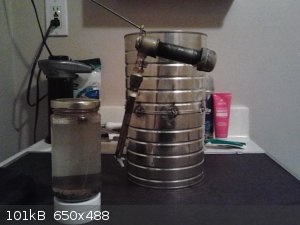
You can kinda see here where the P4 burned up on the threads. There use to be teflon on those pipes now there's nothing.
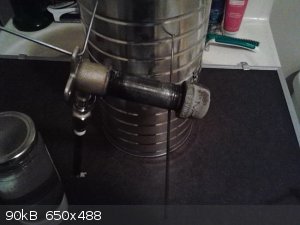
This is a picture of the crud that came out. It wasn't quite as red a few hours ago but does smoke and catch fire when dried.
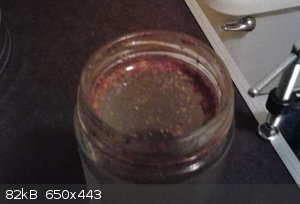
Just another angle. My last batch delivered pure white yellow and SOLID pieces of wax that "magically" appeared at the bottom. The only difference was
I used room temp water back then and my old distiller which I posted pics of weeks back. I also used a lower charge in the retort.
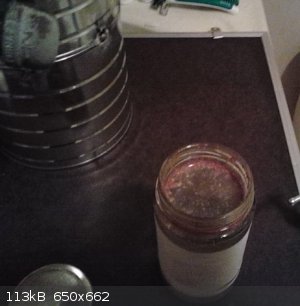
This is the bigger retort that can connect to the smaller one for bigger charges.
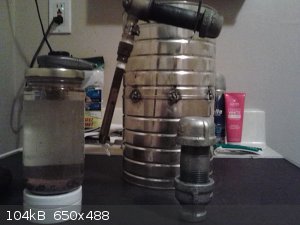
This shows the slag when it overcooked and shot out the distiller rather violently. I don't know why but I feel like this is what made it so red. As
I've never had a slag blow over like this and have also never had my P4 look like gold fish flakes.
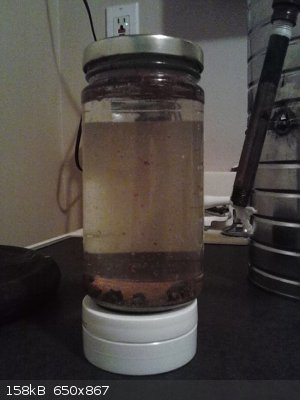
This is a closeup of the 4 brass pieces you can buy at Lowes. There was no breach on any of the brass except the brass to steel connection and steel
to steel connection. And yes, it took me WEEKS just to build this stupid (but effective) distiller.
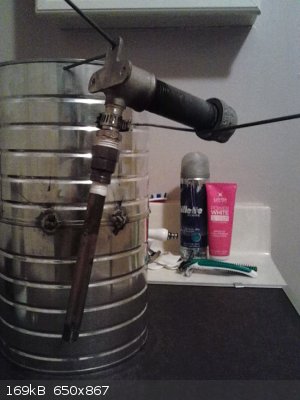
I was trying to recook so see if I could get WP to breach on the steel area which it did not. There wasn't enough left to recook. But you can see
smoke coming out the distiller.
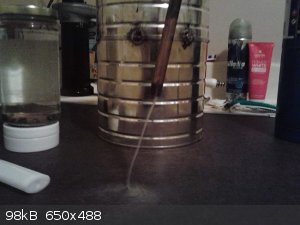
More smoke...
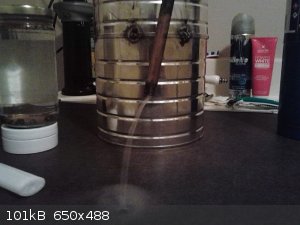
One more...
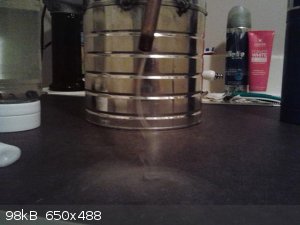
Now the P4 in the distiller ignites and smoke starts to travel upwards...
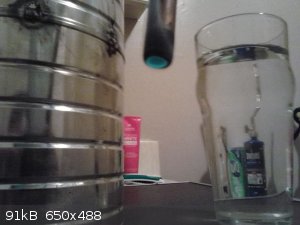
I tried to catch a phosphine burst here but it was too quick (you can't see anything)..
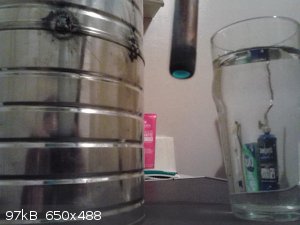
After I dumped the distiller in water I turned the lights out.
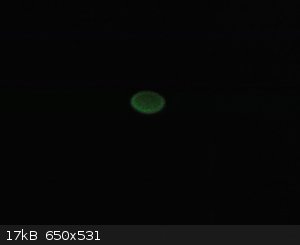
I was gonna take another pic of my previous P4 runs but I have less than half gm left. It's nothing spectacular just 2 small waxy yellow clumps.
Overall I'm not sure why it came out so red this time. It could have been from the breach and overcook as I did turn the heat up real fast once it was
dry. I just know I need a way to effectively seal these steel threads before I can video tape anything worth seeing. There are SO MANY tests I've love
to do. Varying ratios of all sorts of mixes then measuring yields. So tomorrow I'll try making my homemade SiO2 glue. I doubt it will work but I'm
gonna experiment with everything until I find something that can stop these annoying breaches.
It's also weird that I only filled the pipe about 1/3 with powder. But when I unscrewed it the slag had expanded past the elbow and into the top of
the distiller which I banged out with a screw driver.
The last time I cooked I used the same exact mix just a bit less. And when I unscrewed the pipe then more than half the whole pipe was empty. So it
seems like the slag only expands if you overheat as it goes off... which I did. Then obviously if you remove the heat too fast it will freeze in that
form. On the other hand if you remove the heat as it starts cooking (then slowly reapply) the slag doesn't expand. The only reason I didn't remove the
heat I was afraid it might pull water back into the pipe.
At least I know not to do that again. ;-)
edit: Magpie just saw your post. You are spot on about everything. The only reason I thought the tape might hold up was because it was under pressure.
But clearly I won't be using the tape anymore I need a much better sealant.
edit: Just saw the link I appreciate that. I never heard of those fabrics before but that def looks like something I might be able to work with. TY!
[Edited on 14-3-2016 by BluePlanet1]
|
|
|
Magpie
lab constructor
    
Posts: 5939
Registered: 1-11-2003
Location: USA
Member Is Offline
Mood: Chemistry: the subtle science.
|
|
Thanks for the pictures! The safety razor in the background is a nice touch. In case everything goes to hell you can always slit your wrists! 
Some more comments:
1. The reason the ptfe is not failing on the brass tailpipe is that it is considerably cooler that the steel pieces.
2. Waterglass (sodium silicate, a liquid) is a good furnace cement, apparently. I was told this by a foundry worker. It is available from some
pottery material suppliers:link. But this might lock those threads tight.
3. You probably know that furnace cement is available at Ace hardware.
@blogfast
I agree that not every high temperature material on that link will likely be suitable. I would would first try those that have low porosity. The
ceramic paper might work.
At first I thought Garlock's graphite or ss/graphite (Flexseal) gaskets might work but their best "high temperature" gasket was only rated to 538°C.
The single most important condition for a successful synthesis is good mixing - Nicodem
|
|
|
blogfast25
International Hazard
    
Posts: 10562
Registered: 3-2-2008
Location: Neverland
Member Is Offline
Mood: No Mood
|
|
@BluePlanet1:
I think you're over-cooking though. Somewhere much higher up in this thread an experiment of mine with that reaction showed that it needed relatively
little outside heat, to keep going at a gentle pace.
That could explain the extreme slag expansion you seem to be experiencing.
[Edited on 14-3-2016 by blogfast25]
|
|
|
BluePlanet1
Harmless

Posts: 41
Registered: 30-1-2016
Member Is Offline
Mood: No Mood
|
|
OMG I was laughing so hard when I read that razor comment! Hilarious.
I did some research to see what material these factories are using to bind ceramic, silica, graphite, etc to thin papers. Then I just typed in "high
temperature binders" into Google and the first page that popped up was some company selling a bottle of potassium silicate.
Then I came back here and read Magpies comment on the water glass stuff. Then I went to wiki and noticed you can make it with KOH and SiO2 at 90C.
This is GREAT NEWS as I have lbs of KOH that I use as an electrolyte for my HHO torch. Apparently I just have to mix it with silica and I can use this
stuff as a binder with other high temperature powders like ceramic, graphite, etc. I'm so excited right now this is AWESOME! Just hope it works.
And blogfast I think you are right about overcooking. There is really no need for 2 torches on a pipe this small lol.
I'm so glad I found this forum. I feel like I'm on the right path now and will update as things progress.
THANK YOU ALL I'll be back soon. :-)
|
|
|
blogfast25
International Hazard
    
Posts: 10562
Registered: 3-2-2008
Location: Neverland
Member Is Offline
Mood: No Mood
|
|
Yes. But continued external heat is nonetheless needed.
2 NaPO3 +10/3 Al + SiO2 ===> 1/2 P4(g) + 5/3 Al2O3 + Na2SiO3
... is by my evaluation mildly endothermic, so it works by distilling off the P4 vapours.
But one can see how too fast evolution of P4 vapours due to over heating could lead to slag foaming.
[Edited on 14-3-2016 by blogfast25]
|
|
|
Magpie
lab constructor
    
Posts: 5939
Registered: 1-11-2003
Location: USA
Member Is Offline
Mood: Chemistry: the subtle science.
|
|
I had a thought that a lower melting reductant than aluminum (mp=660°C) might work to our advantage. Zn has a melting point of 420°C. I can't
remember if anyone has tried this?
-------------------------------------------
If I was to do any more experimenting in this area I would first decide what size and shape reactor I wanted for significant lab scale production, say
25g of white P per run. Then I would build an electric furnace using Doug's method as shown here: Doug's Lab furnace. This looks like an extremely simple, quick, and cheap way to build a specific purpose furnace.
-------------------------------------------------
I looked in BromicAcid's phosphorus summary in Prepublication for any Zn reductant results. He cites an old reference describing the use of Zn. But
there doesn't seem to be any work reported by SM members.
[Edited on 14-3-2016 by Magpie]
[Edited on 15-3-2016 by Magpie]
The single most important condition for a successful synthesis is good mixing - Nicodem
|
|
|
BluePlanet1
Harmless

Posts: 41
Registered: 30-1-2016
Member Is Offline
Mood: No Mood
|
|
Magpie I must say you are a life savor. I made a batch of concentrated sodium silicate solution today and this stuff is incredible. I chose NaOH over
KOH simply because that's what YT videos were using.
At first I doubted it would have any real adhesive abilities. Then I painted some on a piece of steel. I fired it up and this stuff sticks like super
glue. Another interesting property is as water is driven out the material EXPANDS. Almost like a glassy type of styrofoam. Then as the rest of the
water is driven out it collapses back into a pure solid. Like a very hard, non-porous type of glass.
I was also researching as I was playing with this stuff and it says right in wiki: "When mixed with finely divided mineral powders, such as
vermiculite dust (which is common scrap from the exfoliation process), one can produce high temperature adhesives." https://en.wikipedia.org/wiki/Sodium_silicate#Refractory_use
So I grinded some SiO2 super fine with a mortal and pestle. Mixed them together, in this form (with far less water and Na2SiO3) it fires with minimal
expansion then creates a crazy strong seal. Best of all the seal can be broke by dumping it under water.
As a mere suggestion, I'd say ANYONE trying to make P4 should start by preparing their own batch of Na2SiO3. If I knew about this stuff before it
would have saved SO MUCH TIME trying to perfectly fit pipes together. You can make crucibles with this stuff... repair holes, breaches... it's like it
was made for this reaction. And I must say, I'm yet to actually test it with white phosphorus. But if you can use this as a binder to build non-porous
retorts, crucibles that hold molten iron, high temp furnaces.. I'm very confident it will work for my needs.
As far as Zinc I'll test anything in small amounts then scaled as needed. I already planned on doing mixtures of AL/C/MG so Zinc should be no problem.
The only thing I need to do is build up my supply of SiO2 dust. The blender can get it real fine but I don't have a proper mesh for screening so I'm
going to grind down like 50 more gms of SiO2 with my hands. Just for easy access as I'm running future tests.
And last, if my next cook passes the breach test which I'm confident it will... then finally I can get the camera out and start rapid firing as many
differnt mixes/ratios/yields as possible. I'm gonna beat this horse dead till I understand this reaction like I understand the back of my hands!
|
|
|
BluePlanet1
Harmless

Posts: 41
Registered: 30-1-2016
Member Is Offline
Mood: No Mood
|
|
OK!!!
Did a small scale breach test run and the sodium silicate was a SUCCESS!
I may or may not do pics later (bit busy right now) I just wanted to update so others know.
To prepare the Na2SiO3 I just mixed 40gms NaOH + 60gms SiO2. Then 100ml of distilled water. This was boiled in a stainless steel pot which I prewashed
with hot lye solution just to make sure it was clean.
The first time I prepared sodium silicate it took almost **45 mins** just to dissolve the beaded SiO2.
So on my 2nd run I changed 2 things:
1) Powdered the beads. Do yourself a favor and don't skip this step. It saves lots of time.
2) I used 120ml of distilled water (1/2 cup exactly) as that extra water helps the reaction go faster and you're gonna boil it off either way.
I also made a small scratch in the pot at the level of the water which helps gauge when you need to replete with water.
Don't be afraid to use an excess of water at first. It helps the NaOH dissolve the powdered SiO2 much faster. My second run took a bit less than 20
mins.
---- How I Made My "High Temperature Adhesive"-----
It's really simple. You just grind down SiO2 really really fine with a mortar and pestle. You'll know when it's a "dust" just by the way it cakes and
compresses when you stir it with the grinder. Plus towards the end of grinding you can feel there's nothing left to crush. Make sure you wear a n-95
mask too.
Also, I experimented with mixing SiO2 dust with a very small amount of talc (baby powder/magnesium silicate). I was thinking "since talc is soft, used
as a lubricant and anticaking agent maybe it'll help the final paste spread better." I WAS WRONG! Do not adulterate the silica dust with any talc.
There are guys who line their forges with a mixture like this. For binding to vermiculite. They also add a bit of plaster of paris too which I didn't
do.
But what I found is the talc completely screws up the the pastes ability to bind to metal. It doesn't spread or stick anything like pure silica does.
All you do is pour the silica dust into your FINAL STORAGE BOTTLE. You don't wanna be transferring this paste much after you make it (it's very
sticky).
After I put the silica dust in I SLOWLY added the 99% concentrated sodium silicate solution. Then I stirred it really good. Then you add a bit more.
Stir really good. Keep adding the "water glass" till it turns into a real thick paste. It will take on a thick but pourable viscosity like honey. You
COULD add more water to make it thinner but keep in mind the more water you use the more it expands. That's why I like the paste as thick as possible.
After you make this paste you can SEAL ANYTHING WITH IT. I tested it on copper, brass and steel. It binds excellently to all 3.
And let me add a few notes about curing it. If you cure it with a propane torch the mixture WILL expand. But it does NOT get porous. It creates a
complete seal so no air can get through.
The other way to cure it is to simply paint it on then leave it. After 3-4 hours it'll turn solid to the touch. Very hard. But it'll still have
moisture so you probably want it to sit at least a day. The only good thing about curing with air is it doesn't expand.
The points on my brass distiller where I originally used PTFE tape I let those areas air cure. Technically it still had water in it when I cooked. But
the slightest bit of heat during the reaction immediately cures it. It's really cool stuff in the respect that even if some hot air "leaks" (with
vaporous WP)... the second it hits this stuff it locks up keeps everything inside the chamber.
For the steel threads I painted on a VERY SMALL AMOUNT. By "small" I mean I literally just painted this paste to fill the recesses of the threads. I
did't put huge globs over the whole pipe cause I was worried it might expand too much and damage the threads.
That's something I can't stress enough. You only need a real small amount of this stuff to lock the threads up. And to lock the threads I paint it on
1 end first. I heat that end up to cure it (just 2-3 mins of heat). THEN I fill it with my reactants. After it's charged I paint the other side. Then
I tighten it on with my hands (no wrench). Before I start the reaction I just aim the torch at the end that doesn't have the powder. And I cure that
end a bit slower with a bit less heat for 4-5 mins. This way it cures at lower heat without the powder reacting. And TBO even if the powder did go off
I see no way how it could get through this paste. It just locks up and hardens so fast. I was also watching for any extra phosphine and didn't see
anything abnormal.
Finally, when the reaction is done you can dump the whole thing in hot water outside. That will get into the threads and unlock it. What I did instead
(to save the external seals on the distiller) was hit it with a hammer then wrench it off like superman. It was a serious PITA. Next time I'm just
dumping the whole thing in water cause I'm gonna destroy the threads if I do that again.
That's about it for now. I just proxied my YT account today so I'll be moving to video after this. And I also gotta order some Zinc from ebay.
Be back soon,
-BP
|
|
|
Magpie
lab constructor
    
Posts: 5939
Registered: 1-11-2003
Location: USA
Member Is Offline
Mood: Chemistry: the subtle science.
|
|
Quote: Originally posted by BluePlanet1  | OK!!!
Did a small scale breach test run and the sodium silicate was a SUCCESS!.....
That's about it for now. I just proxied my YT account today so I'll be moving to video after this. And I also gotta order some Zinc from ebay.
|
That's really good news. Thanks for the details on making the cement.
About the use of zinc as reductant: I went back into this thread to see what I could find out about the use of zinc. I didn't find
much except someone stated that this would form zinc phosphide. That would be bad news! Phosphides react with water to make phosphine which
is highly poisonous. So I have to retract my suggestion to try it. It should only be tried if you are fully prepared for the production of
a considerable amount of phosphide/phosphine. I would only try it on a very small scale with excellent ventilation, ie, a powerful fume hood.
The single most important condition for a successful synthesis is good mixing - Nicodem
|
|
|
BluePlanet1
Harmless

Posts: 41
Registered: 30-1-2016
Member Is Offline
Mood: No Mood
|
|
Quote: Originally posted by Magpie  | Quote: Originally posted by BluePlanet1  | OK!!!
Did a small scale breach test run and the sodium silicate was a SUCCESS!.....
That's about it for now. I just proxied my YT account today so I'll be moving to video after this. And I also gotta order some Zinc from ebay.
|
That's really good news. Thanks for the details on making the cement.
About the use of zinc as reductant: I went back into this thread to see what I could find out about the use of zinc. I didn't find
much except someone stated that this would form zinc phosphide. That would be bad news! Phosphides react with water to make phosphine which
is highly poisonous. So I have to retract my suggestion to try it. It should only be tried if you are fully prepared for the production of
a considerable amount of phosphide/phosphine. I would only try it on a very small scale with excellent ventilation, ie, a powerful fume hood.
|
Ok, I just had to try since this is such a mystery.
I just made 1.1gm crude zinc powder from 97.5% zinc pennies. It had a bit of copper but at that % I figured why not?
I used 6.8gm NaPO3 + 1.6gm SiO2 that are used for the Al reduction. Ground as fine as baby powder. Then mixed 2.8gm of those reactants with 1.1gm of
crude zinc. The zinc powder was a bit coarse, but still mixed very thoroughly.
All I wanted to see is what would happen when cooked in open ventilated air like I've done with Al before.
I held the mixture over my propane torch.... waited.... waited... everything got bright orange... nothing was happening... then suddenly I see a
couple of blue sparks with white smoke. Characteristic zinc burning in air. Immediately after those sparks the whole mixture slowly started that P4
volcano cook. Where 1 side turns white hot with a ring of orange around it from escaping phosphorus. Then the ring expanded over the whole pile and
cooked to death releasing lots of white smoke.
Interestingly enough what was left afterwards was a very bright, almost white/yellow powder with random pockets of dark grey.
According to wiki Z2P3 is suppose to be very dark grey almost black. But what puzzled me was all the white yellow. The slag was packed with some type
of metal oxide it had to be zinc.
Anyway, when it cooled down I put water on it and saw not 1 bubble.
Based on what I just saw... the zinc is most definitely going for the oxygen and not the phosphorus.
I can't say that for sure yet but I'm definitely ordering higher grade powder and this needs to be tested. 
|
|
|
Magpie
lab constructor
    
Posts: 5939
Registered: 1-11-2003
Location: USA
Member Is Offline
Mood: Chemistry: the subtle science.
|
|
Quote: Originally posted by BluePlanet1  |
...Anyway, when it cooled down I put water on it and saw not 1 bubble.
Based on what I just saw... the zinc is most definitely going for the oxygen and not the phosphorus....
|
Very interesting. But on a larger scale in a closed retort access to atmospheric oxygen will be restricted. This may promote the formation of
phosphide.
Please be careful.
The single most important condition for a successful synthesis is good mixing - Nicodem
|
|
|
blogfast25
International Hazard
    
Posts: 10562
Registered: 3-2-2008
Location: Neverland
Member Is Offline
Mood: No Mood
|
|
Quote: Originally posted by Magpie  |
Very interesting. But on a larger scale in a closed retort access to atmospheric oxygen will be restricted. This may promote the formation of
phosphide.
Please be careful.
|
Personally I think Zn3P2 could only be formed if an excess Zn is present.
|
|
|
| Pages:
1
..
47
48
49
50
51
..
60 |